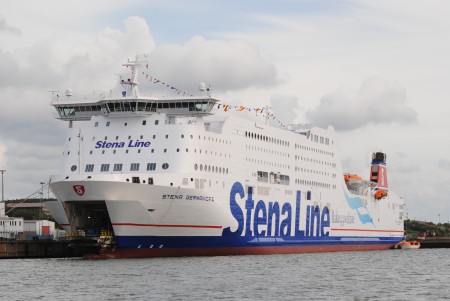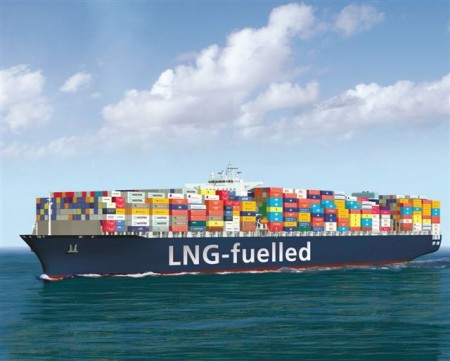March 3, 2016 – In a sub-headline from an article appearing in The Guardian six years ago comes the following:
“One giant container ship can emit almost the same amount of cancer and asthma-causing chemicals as 50 million cars”
A scary thought when you consider that the December Paris meeting on climate change chose not to establish emission standards on marine shipping for the present. That 2009 article further stated, ” just 15 of the world’s biggest ships may now emit as much pollution as all the world’s 760 million cars.”
In 2009 world maritime shipping produced as much as 30% of atmospheric nitrogen oxide pollution and almost 4% of all climate change emissions. That was 2009 and the problem remains and in fact has grown as China has added a number of super container ships to the world’s oceans. Each of these uses diesel engines as big as land-based power stations and all run on bunker oil. But before we talk about bunker oil in greater detail we should talk about the International Maritime Organization (IMO) and its efforts to date to address global ship pollution.
The IMO has created MARPOL, an international convention for the prevention of pollution from ships. In 2010 it adopted Annex VI, a provision for shipping companies to address sulphur dioxide, nitrogen oxide and particulate matter air pollution with an agreed to emission reduction strategy to be implemented starting in 2020.
Because marine pollution was not part of COP21 it appears the industry got a “get out of jail” free 5-year pass. This is indeed unfortunate because “pollution from the world’s 90,000 cargo ships leads to 60,000 deaths a year.” Which brings us back to the cause of this pollution, the industry’s heavy reliance on bunker fuels, the dirtiest source of burnable energy in commercial use today.
At one time bunker fuel was an answer to an even dirtier marine fuel, coal. Back in the 19th century and indeed into the early 20th, coal was the marine fuel of choice. But World War One marine technology advances led to a wholesale conversion of marine fleets which now began using oil. One of the motivators behind Japan’s Pearl Harbor attack in 1941 was to ensure the country established dominance over Indonesian oil by eliminating America’s Pacific fleet, giving the Empire a buffer to continue its South Asian conquests. The gamble failed but bunker oil remained the marine fuel of choice. It was seen as far cleaner than coal and far more transportable. But as a fuel for a 21st century in a war to combat climate change, there can be nothing much worse (coal excepted).
Bunker oil is the residual oil left after refineries distill gasoline, diesel and natural gas from raw crude. Bunker oil, therefore, contains all the impurities left over after distillation including residual heavy metals, sulfur and particulate matter. It comes in many grades determined by viscosity. The dirtiest and cheapest fuels are the most viscous. When burned it produces a powerful energy punch liter per liter but along with that energy comes a high volume of airborne pollutants in the form of ash (particulate matter) and greenhouse gases.
Are there alternatives to bunker fuel?
The answer is yes.
In the past we have written about marine innovations to address the bunker fuel challenge, technologies like advanced scrubbers to clean emissions, rigid sails with integrated solar panels, hybrid diesel-electric drives and more. These have largely been one off projects with no significant impact on marine fleets.
Interim alternative fuels that could be introduced into the mix include liquid natural gas (LNG) and bio-fuel (methanol). These are preferable to bunker fuel because they produce less greenhouse gas emissions. They could be the interim answer for the industry, a bridging technology before the transition to fossil-fuel free marine transportation systems.
LNG as an Alternative to Bunker Fuel
LNG is a controversial topic in Canada right now. In British Columbia, Royal Dutch Shell in the last month put a hold on a $40 billion (CDN) project to build a LNG export terminal. The Canadian government had recently green-lighted Shell the permit to proceed but volatility in the world oil markets led to its 9-month startup postponement. The natural gas source for this project are fields in the Horn River and Montney Basins of northeast British Columbia where fracking operations have been ongoing for more than 60 years. There are existing pipelines in British Columbia to transport the gas to the west coast where it would be liquefied and put on board ships headed to South Asian markets.
LNG is currently being used as an energy source for marine shipping. Last year a United States marine carrier commissioned its first LNG-fueled container ship as well as a bulk LNG supply ship. The European Union (EU) published its own 2015 report on the environmental advantages of Using LNG to fuel marine fleets. The EU report concluded that LNG is attractive for its environmental impact but that a profitable business model had yet to be established. In light of the drop in world oil prices since that report was published, the business model for a marine LNG fleet remains dubious. To date there are 20 to 25 LNG-fuelled vessels in operation, less than 1% of the total commercial marine fleet. The advantages of LNG are this. As a fuel it meets all the environmental standards established under MARPOL’s Annex VI. The disadvantages – the marine technology implementation is expensive. Converting existing fleets to LNG will take considerable time, and LNG fuel infrastructure equivalent to current bunker fuel sources is non-existent. The LNG terminals planned for British Columbia could contribute to this infrastructure but the current plans are focused on LNG export. That is understandable considering the lack of significant marine fleet of LNG-fuelled ships.
Bio-fuel as an Alternative to Bunker Fuel
The first methanol-powered ferry made its debut in March 2015 in Europe. The EU’s efforts to reduce emissions in local shipping lanes, inspired this project. The ship, Stena Germanica, is operating between Kiel, Germany and Gothenburg, Sweden. It uses a dual fuel system capable of running totally on methanol, or marine gas oil as a backup.
The EU hopes this demonstration technology will prove an effective live test for methanol as a future marine fuel. Part of the project includes development of engine conversion kits to retrofit existing ships reliant on bunker fuel. The project also includes the building of appropriate port infrastructure for supplying methanol as well as a methanol-supply vessel.
Maersk in cooperation with the United States Navy is also experimenting with algae-based biodiesel, a two-year trial on the container ship, Maersk Kalmar.
Another bio-fuel experiment called GLEAMS, uses glycerine-based fuel, a byproduct of biodiesel production, in marine shipping.
Methanol fuel cells are being developed by a consortium of companies from Finland, Sweden, the UK, Italy and Norway.
In the United States, the Coast Guard is testing bio-butanol for its small marine craft.
Is the effort by marine operators and governments sufficient to meet the global need to reduce carbon and greenhouse gas emissions? Not yet. Let’s hope as COP21 commitments begin to take hold that this important omitted sector becomes an active participant in a global effort to transition to a low-carbon future.











